Porcelain Insulator News
by Jack H. Tod
Reprinted from "INSULATORS - Crown Jewels of the Wire", October 1975, page 21
Preferably direct porcelain news items and questions directly to Jack H. Tod,
3427 N. 47th Place, Phoenix, Ariz. 85018. All mail will be answered if reply
stamp is enclosed, and the most newsworthy items and questions of general
interest will be published as space permits.
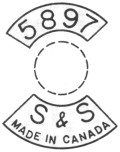
Dear Jack:
I'd like some information on the following two insulators. I believe both are
"Smith & Stone".
The 5897 marking is on a standard 3" secondary rack spool and is recess-embossed around the top.
The pin type is about a U-294A, and the double Diamond-S is applied on the
crown.
John Berard
Port Alberni, B.C.

- - - - - - - - - - -
Dear John:
You are correct. Colin McIntosh ("Canadian Insulators", $3), page
74, states this is Smith & Stone's trademark.
Company information from my files: Smith & Stone Ltd., 2 Glen Road,
Georgetown Ontario, Canada. Established 1920. Among many other things, they
manufacture both wet process and dry process porcelain insulators.
McIntosh says this is the only Smith & Stone pin type, and I hadn't heard
of one in the flesh until your report. Other Canadian collectors should be
seeking this company marking, so it might be a good swapper.
Jack
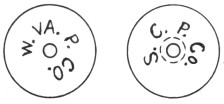
Paul LaSalle (Rome, NY) just reported two more now split knob markings.
The nail knob at the left in undoubtedly West Virginia Porcelain Co., New
Haven, W. Va. This company was founded in 1919 and became defunct (bankrupt) in
1925. Subsequently it became Superior Porcelain Co., and see pages 28-29 of the
June 1974 Crown Jewels for complete plant history.
The marking on Paul's screw knob at the right above is unattributable by me.
I can't match up the S. C. with any porcelain company in my historical files or
old directories.
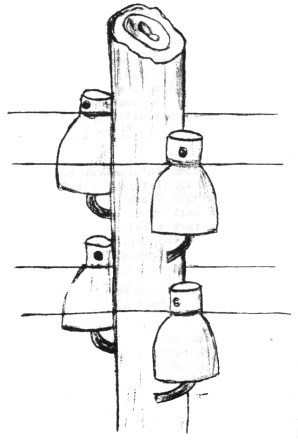 |
| This is a true reproduction of an old lithographed Easter greeting card
(partial). These insulators have been reported in another totally different
use. GEB |
Gerald Brown (Colo.) got this antique greeting card from Rod Wing (Mich.) and
which is an artist's painting of bluebirds alighting on the wires - all of which
led Rod to comment that this proved porcelain insulators are for the birds! The
insulators are a foreign style, and Ken Schumacher (Ohio) told me in 1973 that
catalogs showed insulators identical to these were made by Thomas (for export?).
We'll give a gold star to anyone who can tell us why the hole in the crown.
After futile attempts to get a printable photo of this color card, Gerald
made for us this reproduction of the insulator portion of it.

Walt Lehnert (Minneapolis) sent two more unreported #334 wiring cleats.
The E. ENG. CO. one stumps me.
The one with the bold, recess-embossed diamond is probably Diamond Porcelain
Co., Trenton, N.J. I never could find any location for or reference to this
company while in Trenton. We only know it was one of several companies which
ended up becoming General Porcelain Co. in the 1913 mergers.

Emma Almeida (One Bay Drive, Shrewsbury, MA 01545) reports having two more
previously unreported cleat markings.
The RELIABLE is undoubtedly for Reliable Electric Co., Chicago, Ill., mostly
involved with telephone and telegraph equipment -- fusing, lightning arrestors,
etc. I've seen their name on numerous such items, and also a RECO. marking they
used on porcelain items, but this is the first report of their name on wiring
cleats.
The C. I. Co. is for Colonial Insulator Co., Akron, Ohio -- now defunct.
Briefly, the plant history was:
Initially founded (date ??) as Akron Insulator & Marble Co. (A. I. &
M. Co. marking on insulators). Consolidated with Colonial Sign Co. in 1904 to
become Colonial Sign & Insulator Co. (C. S. I. Co. and C. S. & I. Co.
markings on insulators). Subsequently (after 1920) changed name to Colonial
Insulator Co. (the above C. I. Co. marking).
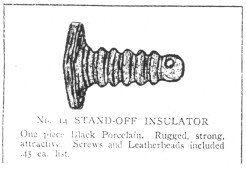 |
Image text:
No. 14 STAND-OFF INSULATOR One piece Black Porcelain. Rugged, strong,
attractive. Screws and Leatherheads included .45 ea list. |
Walter Lehnert (Minneapolis) sent a copy of a catalog page of M. M. Fleron
& Son, Trenton, N.J. showing this item reported in the June 1975 CJ to be a
stand-off insulator for radio use. Thanks Walt; you're a walking encyclopedia
for any of these radio items.
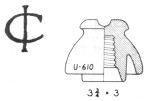
Here's another interesting mystery marking on a U-610 I got at the San Diego
show. This bold, incuse cents sign is stamped on top of one crown ear. The
insulator is a No-Name, but it looks like a Locke Insulator Corp. product.

The parade of errors in marking stamps used by Imperial Porcelain Works
continues with this one just reported by Paul Mohre (Michigan City, Ind.). Note
the N.I. for New Jersey.
Reference Fred M. Locke marking stamps, April 1975 CJ page 29, Robert Winkler
(Indiana) reports he recently captured a U-964 glazeweld with marking #6-1 but
which has "Sept 24" instead of "Sept 28" -- and he compared
it with the other marking on a different specimen.

Ed & Judy Gish (Texas) were the first ones to report the Fred Locke error
in the dating stamp used on insulators. Theirs is on a U-925, and the
manufacturing date reads SEPT 12, 9101.
Jerry Turner (Ohio) also got one with this error while visiting Fred
Richardson (Colo.) on the way back from the San Diego National. It's also a
U-925. More importantly, Jerry also reported getting a U-925 with the #3-1
marking, and this is the first I knew of Imperial Porcelain having made any of
these U-925 for Fred Locke.
Paul Mohrs (Indiana) sent us three new Fred Locke marking stamps and
completed or corrected several more. All you Locke fans can add these to the
listing. All are incuse handstamps, serifed letters except as noted below.
|
F. M. LOCKE, VICTOR, N.Y. |
0-7 |
|
|
F M. LocKE
PAT
DEC. 15 . 96 |
1-5 |
(correction) No period after F -- high period
after 15 instead of a comma. |
|
Pat'd June 7,1898
FRED M. LOCKE. |
1-9 |
Lower case letters in top line. No
address. |
|
Pat'd June 7,
1898
FRED M. LOCKE. |
1-10 |
Similar #1-9, but big type for 1898,
low 7. |
|
PAT. NOV 24 & DEC 15 '96
SEP. 28, 97 June, 7 98
F. M. LOCKE VICTOR, N.Y. |
4-1 |
(Correction) Caps top
row all same size, two commas instead of periods. Sans
serif. |
|
PAT'D NOV. 24 & DEC 15 96
SEP-28 & JUNE 7
98
FRED. M. LOCKE VICTOR. N.Y. |
4-3 |
(Correction/completion) PAT'D instead of PAT. Extra small N.Y. sans serif
letters |
As a reminder, lower case (small) letters are shown that way above.
Underscored capitols are larger type than other capitols in the stamp.
It's getting pretty obvious the Victor plant had a whole raft of
miscellaneous handsetting type ole Fred probably bought from a defunct printer
at the flea market of the 1890's. The workers set this type up in a sloppy
fashion and probably locked it up with a rubber band or some tape.
When the mess fell apart, they probably reset it or started all over. In any
event, this probably accounts for the numerous minor variations in these many
marking stamps used during the 1898-1909 period by Fred Locke. I'm sure our
listing isn't complete yet, and we may still have some inaccuracies, but we'll
keep chipping away at it. Everyone has said that the listing has been a
tremendous help in their cataloging and swapping activities.

Chris Hedges (K.C., Mo.) writes wanting info on a Fred M. Locke similar to
U-447. Usual light tan glaze, marking #1- 8 on skirt.
As different from the U-441 Fred Locke with the tiny top groove, this later
item is the original Locke #2 cataloged in 1902 and 1905 Locke catalog just as
Chris described it. This design continued essentially without change for many
years, still U-447 in the 1913, 1916 and 1925 Locke catalogs. In more recent
years, the Locke #2 underwent some evolutionary changes in general shape, mostly
changes in the crow design and an extended petticoat.
A number of collectors now have the U-441 Fred Locke, but this is the first
U-447 Fred Locke reported to us.
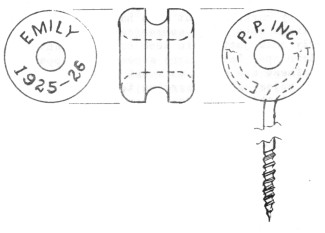
Gerald Brown (Two Buttes) writes that the Plank brothers (La Junta,
Colo.) have
a small knob with the EMILY marking in conjunction with P. P. Inc. and wonder if
this attributes the EMILY.
Well, No! The EMILY is a generic name for "screw eye" insulators
sold by everyone, just as everyone sold "B & D" cleats. What would
be a real victory is if we could find out who or what Emily was.
Incidentally, the 1925-26 on this screw eye are not dates but are catalog
numbers of Findlay (later P. P. Inc.) for these gismos. Their use of catalog
numbers in the 1900- 2000 block on knobs, screw eyes and wireholders causes
considerable collector confusion as to their appearing like dates.

Ron LaSalle (Rome, NY) reports yet another mystery marking, incuse on the
dome of a P.R. Hat similar U-297. We'll never know what these stamps meant, but
they're interesting nevertheless.
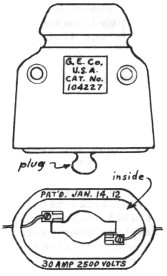
Dear Jack:
Just purchased this odd piece and would like some information please. I'm
primarily a glass collector, but do have a few porcelain pieces.
This in a pretty heavy insulator & dark brown in color. Thanks for the
help & also for the information I get from "Crown Jewels".
Jeff Franklin
Menasha, Wis.
- - - - - - - - -
Dear Jeff:
We printed this answer in the July 1973 issue and again in Feb 1974 but
questions on it are up to better than once a month again so it's time for a
repeat answer.
This is a "primary fuse cutout" (a plug-type fuse cutout), and they
have been made from the mid-1890's up to modern times. There are many minor
variations due to different company manufacture and design evolution, but they
all generally have the same appearance and all serve the same function. The
majority have poleline hardware company markings, but some have porcelain
manufacturer markings when these companies carried them as catalog items. Early
ones just plain look crude and antique like. More modern ones have a more
streamlined appearance.
These are meant to mount on crossarms (with the two bolt holes) at the
service transformer poles, and they provide the fusing for the primary (high
voltage) side of the transformer. The removable plug in the bottom has a
renewable fuse wire attached to it.
The more modern (current) fusing method is a link-type fuse which is held in
spring clips mounted at the ends of the lightning arrestor housings on the
transformer poles. These fuses can be changed from the ground with long
telescopic poles made for that purpose. This is not only much easier, but the
older plug-type fuses weren't termed "suicide boxes" without good
reason.
If you look at the transformer poles in the alley behind your house, you can
see the fusing method used. There are other plug-type primary fuses besides this
general design, and some oddballs may still be in use in some areas of the
country.
Jack

Edgar B. Smith (Union Springs, NY) has what I think is a most unusual factory
marking error. This is the C.N.R. handstamp struck over the C.P.R. marking,
presumably on on the usual beehive pin type. Ed furnished this marking sketch
but wasn't specific as to which of the several different handstamps were
involved.
All these white beehives were made for these two Canadian railroads by
Pittsburg High Voltage. A standout error item for anyone collecting railroad
items!
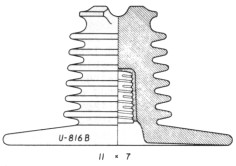
Dear Jack:
... Have a U-816B marked LOCKE / 2355. These may be seen in the air just
outside of St. George, Utah. The line also had some large Pyrex pin types. Must
admit to doing a double take when seeing them in the air for the first time. Not
successful in attempts to purchase insulators from the local utility there.
Howard Sussman,
Santa Ana, Cal.
Dear Jack:
Re your article in August 1975 CJ, page 29. We're on vacation and saw some
U-816B on a line together with some large Pyrex glass insulators. They are in
Utah, northeast of St. George, north of Hurricane towards LaVerkin on Route
15....
Mr. & Mrs. Wes Gordon,
San Diego
- - - - - - - - - -
Yes, I too just returned from a two-week trip to Tennessee and spotted a
U-816D on a line west of Oklahoma City along 1-40. All the other insulators on
this line (about 20 miles) were large multis except for this single U-816B, and
I watched it again on the way home.
When you see one of these on a line, "double take" is an
understatement. I never saw anything quite so wierd looking on a pole, and I've
seen some very oddball pole-line construction in my travels. This U-816B was
obvious several poles away, and I nearly broke my neck staring at it as we
passed by at 55 mph.
Jack
| 